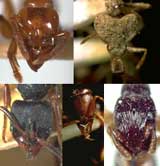Ants make web

Researchers can now crawl through data on 11,000 ant species. <br>© Antbase <br>
Formidable catalogue puts army of ants online.
After four years of cooperation and tenacity worthy of their quarry, ant experts have completed Antbase, a centralized, online information resource cataloguing all 11,000 known species of ant.
Its creators hope that Antbase will one day become the ant equivalent of GenBank, the public database of genetic sequence data, and a boon not just for ant specialists, but for entomologists and ecologists of every kind.
Ant taxonomists Donat Agosti of the American Museum of Natural History in New York and Norman Johnson of Ohio State University in Columbus built Antbase using funds from general research budgets and small institutional grants. Having compiled a full list of ant names, they hope their homespun project will now win long-term funding and a permanent home. “It needs to be institutionalized,” says Agosti.
The database’s backbone is an updated list of species names. Compiling the list was anything but trivial, Agosti and Johnson say. Descriptions of new species published in obscure journals over the past century had led to heavy duplication. As the project progressed, Antbase shrank to its current size from an initial list of over 20,000 names. “We’re trying to pick up the debris from nineteenth-century taxonomy,” says Johnson.
Records for each species are being linked to information on their geographical distribution and life history, plus pictures held by the Japanese Ant Color Image Database.
Antbase could emerge as a long-needed resource for ant taxonomists, says Ted Schultz, who works as one at the Smithsonian Institution in Washington DC. “Before, you had to spend hours photocopying thousands of pages of primary literature,” he says. The resource could also aid more general studies of ecosystems, where ants often have a prominent role. “Ants are an incredibly useful ecological indicator,” Schultz adds.
Media Contact
More Information:
http://research.amnh.org/entomology/social_insects/All latest news from the category: Life Sciences and Chemistry
Articles and reports from the Life Sciences and chemistry area deal with applied and basic research into modern biology, chemistry and human medicine.
Valuable information can be found on a range of life sciences fields including bacteriology, biochemistry, bionics, bioinformatics, biophysics, biotechnology, genetics, geobotany, human biology, marine biology, microbiology, molecular biology, cellular biology, zoology, bioinorganic chemistry, microchemistry and environmental chemistry.
Newest articles

Properties of new materials for microchips
… can now be measured well. Reseachers of Delft University of Technology demonstrated measuring performance properties of ultrathin silicon membranes. Making ever smaller and more powerful chips requires new ultrathin…

Floating solar’s potential
… to support sustainable development by addressing climate, water, and energy goals holistically. A new study published this week in Nature Energy raises the potential for floating solar photovoltaics (FPV)…

Skyrmions move at record speeds
… a step towards the computing of the future. An international research team led by scientists from the CNRS1 has discovered that the magnetic nanobubbles2 known as skyrmions can be…





















